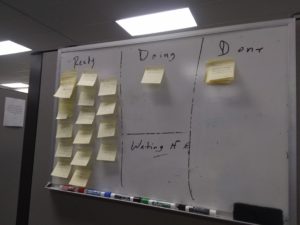Next, I did a preliminary ordering of tasks in the “Ready” column, then I selected two tasks to add to the “Doing” column. This would be my “work-in-progress” items. The book Personal Kanban recommends limiting how many items you are working at a given time (see also Personal Kanban 101 and my introduction to Personal Kanban). This helps to focus effort on getting tasks completed. When I create a Post-it note, I write the task description and the date I am creating on the note. I include the date so I can see how long it takes to do a task. If I look at the end of the week and a task I created at the beginning of the week is still in the “Ready” column, I might consider moving it up in priority.
I like to define tasks so that I can get them done in half a day or less. It’s also ok if a task only takes five or ten minutes. Another strategy I use is to mix up shorter and longer tasks. Using this technique, I feel I like I am getting more done. When I don’t write tasks down, I start to feel anxious and unorganized. When that happens, I try to review what is on the board, see if I need to add any tasks, then get back to one of the tasks in the “Doing” column. If I have an interruption, I may create a new task to provide a next action or closure to that interruption, then resume the task I was working on prior to the interruption. I try to defer working on the interruption task until I complete my prior task. In that way, I can make more progress on the work I have already defined for myself.
When I complete a task, I move it over to the Done area of the kanban board. I also stack all of the tasks that I complete during the day. This also helps to provide a feeling of accomplishment as the stack grows. During the day, as I think of more tasks, I create a new Post-it note and add it to the Ready column. Sometimes, I will rearrange my backlog order based on an external stimulus (someone needs something NOW). The important thing for me is to capture tasks as I think about them, and not keep them in my head (similar to the GTD step of collecting tasks/information). If a task reaches a sticking point, I move it to the “Waiting” area of the board, and make a note of what is needed for this task to be resumed.
The Personal Kanban technique has been a great tool for me to keep up with my job. I like the ease of a physical system, but many people like using tools like Kanbanchi or Trello to be able to access tasks from wherever they might be. Regardless of the tool, the Personal Kanban system is a powerful way to get a better handle on your work. Give it a try!
